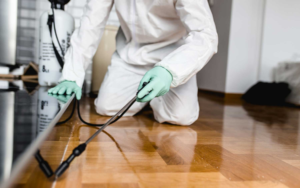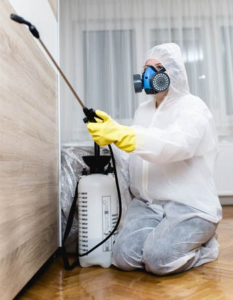Exterminator Boise is an important service that prevents the spread of diseases like plague, typhus, flea-borne spotted fever, and Salmonella. These unwanted organisms can cause property damage and pose a threat to public health.
Chemical pesticides are a common form of pest control. They come in the form of sprays, dusts, and baits.

Pest identification is a critical first step in any pest control situation. Proper pest identification helps prevent incorrect control tactics, which can lead to unnecessary damage to crops or other organisms, as well as unnecessary risks for people and the environment. Identification may be based on morphological traits, such as the structure of mouthparts or wings; or behavioral characteristics, such as flight patterns or behavior around the host plant. The pest’s life stage, such as egg to larva or adult, may also affect its appearance.
Many pest species change drastically in physical form throughout their lives. For example, a weed seedling often looks quite different than the mature plant that is targeted for control. Some insect species are also highly mobile and can move from field to garden or from a tree to a home. For these reasons, pest identification is especially important for preventing overuse of pesticides.
For example, the label on a commercial pesticide product typically lists the specific species of pest that it can be used against. This is a safeguard to avoid accidental misuse of the product by using it against an organism other than that for which it was intended.
In addition, pest identification is essential for ensuring the proper selection of a management strategy. For instance, if a pest can be identified to the order level (Lepidoptera or Coleoptera), products can be selected for control that are very specific and targeted against this group of insects. This can minimize collateral damage to other organisms, such as non-target plants or beneficial insects.
The ability to correctly identify pests allows people to use a variety of control methods without the need for expensive and potentially harmful chemical treatments. In many cases, a weed or insect infestation can be brought under control through the use of sanitation, managing moisture levels in and around structures, storing firewood properly, vacuuming, sealing entry points into homes, using a dehumidifier and other management techniques. Similarly, rodents and other pests can often be controlled by correct sanitation, removing food sources, sealing cracks and crevices and making the environment less welcoming or conducive to their survival.
Pest Prevention
Pest control is the effort to prevent pests, such as cockroaches, ants, rodents and other unwanted creatures from invading a building or other area. This is accomplished by removing food sources, starving pests and blocking their access to shelter or water. Preventive measures may also include modifying a building’s surroundings to make it less attractive to pests, such as clearing away overgrown shrubbery and keeping trash cans sealed.
Pest prevention can be a difficult task, particularly in industrial settings where employees may be moving throughout the facility on a regular basis. A thorough pest prevention strategy requires buy-in from the entire staff, especially at higher management levels. This involves assigning a person on each shift to inspect incoming shipments for signs of pests, determining which areas of the plant should be wet washed rather than dry washed to reduce moisture seeking pests like cockroaches and flies and establishing uniform cleaning practices to prevent employees from accidentally introducing pests into locker room areas.
Some pests, such as adult beetles and moths, are drawn to light. Installing screens in windows, closing curtains at night and keeping lights turned off during the day can help to keep these pests out. Thoroughly scrubbing rarely used cupboards and storage spaces several times per year and vacuuming under furniture will also make these places less appealing to pests. Similarly, washing and properly storing woollen clothing before putting it away for the winter can help to avoid a moth infestation.
In addition to modifying the physical environment, effective pest prevention involves eliminating food sources and reducing clutter that could serve as hiding spots for pests. For example, removing rotting fruit and vegetables from outdoor picnic tables can help to deter hungry pests. Similarly, washing out empty food containers can make them less appealing to pests and it is best to use trash cans with lids.
Understanding a pest’s life cycle can also be helpful. By knowing that a pest may go through many phases before becoming a visible nuisance, it is easier to identify the correct time for control measures to be taken.
Pest Control Methods
Pests can cause a variety of problems including damage to crops, plants or property; nuisance for people living in buildings, parks or homes; and health hazards such as rodent droppings (which carry diseases such as salmonella) or cockroaches that may carry mites or fungus that can cause human illness. Suppression and prevention are usually the goals of pest control, but eradication may be pursued when circumstances warrant it.
Physical controls can include barriers and exclusion. Barrier sprays create a boundary that pests can’t or won’t cross. For example, a door sweep seals a gap under doors, blocking rodent and insect entry into a home. These methods are most effective when pests use predictable paths and can be especially helpful when combined with other preventive measures, such as reducing food and water sources by eliminating attracting debris or sealing cracks where pests enter buildings.
Chemical pesticides are generally the most widely used forms of pest control. They are available in a range of products, including aerosol sprays, dusts, baits and gels. Most are formulated to target specific pests and work by disrupting nervous systems, killing the pest or preventing reproduction. While they are generally regulated and not harmful to humans, pesticides can pose environmental concerns if overused or applied inappropriately.
Biological pest control uses natural predators and other organisms to manage pest populations, usually without harming the environment or other beneficial species. This form of pest management is usually suited to agricultural settings and can be effective in reducing the risk of damaging, invasive species.
Biological pest control methods can also include beneficial insects, nematodes, fungi and bacteria. For example, the nematode Steinernema carpocapsae attacks and kills the grubs that feed on grass roots. Other types of nematodes attack other unwanted soil organisms such as fleas, grubs and slugs. Beneficial nematodes are available as ready-to-use formulations and can be sprayed in large areas to quickly cover a lot of ground. They can be a cost-effective alternative to conventional chemicals. In addition, fungi and bacteria can be applied to the soil in liquid form to reduce or prevent infestations of other pests.
Pesticides
A pesticide is a substance or mixture of substances that kills, prevents or reduces the damage caused by insects, mice or other animals, unwanted plants (weeds), fungi or bacteria. Pesticides can also modify a plant’s growth (regulator), cause it to drop its leaves prematurely (defoliant) or act as a drying agent (desiccant).
Pesticides may be natural or man-made, and they can be organic or inorganic. They can be biodegradable, breaking down easily in the environment, or persistent, taking months or even years to break down. They can be used on the surface of soil, water or inside buildings or structures. They can be vapors, gases or liquids. They can be sprayed, poured or dropped. The products used in schools are called “organic” or “chemical” pesticides, but this does not mean they are safe. In fact, many are very toxic.
The most commonly used types of pesticides are insecticides, herbicides and fungicides. Insecticides are the most acutely toxic, killing pests by attacking their nervous systems. Herbicides are generally less acutely toxic, but they can still interfere with the cellular processes that control growth, development and reproduction. Fungicides can be both acutely and chronically toxic.
In general, the more concentrated the pesticide is, the more risk it poses to humans and other living things. The pesticides formulated for home and garden use come in low concentrations that are very safe to handle, but the same active ingredients are available in much more concentrated formulations for agricultural and industrial uses.
When using pesticides, be sure to follow the instructions on the product label carefully. Be especially careful not to spray where people or other animals will be present, and do not apply on windy days. If a spill does occur, clean it up promptly. Cover the spill with sand, vermiculite or kitty litter to keep it from washing away, then sweep up and dispose of it according to the directions on the product label.
Even baits containing feed attractants can be considered pesticides, since they still kill or repel the targeted animal. If you choose to use baits, it is important to provide them in locations where children or pets cannot reach them.



